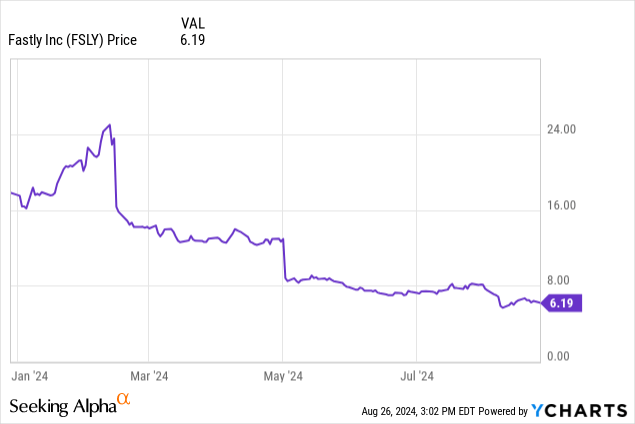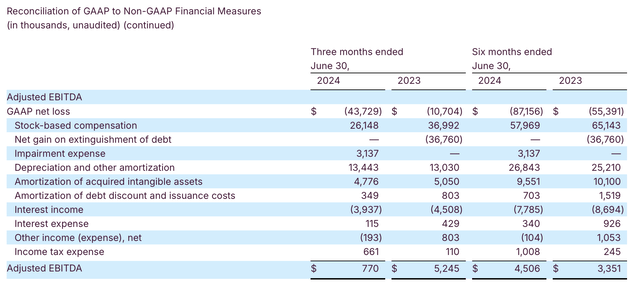Amid tougher macroeconomic conditions, many software companies are faltering. IT budget optimization has led net retention rates lower, while those companies with exposure to small and mid-sized businesses (SMBs) have also dealt with higher churn.
These issues have plagued Fastly (NYSE:FSLY), a content delivery network (CDN) that was once a high-flying stock during the pandemic era. The company is now trading at a fraction of its former value, and a series of guidance cuts this year has brought the stock down more than 60% year to date.

I last wrote a bullish opinion on Fastly in June, when the stock was trading in the mid-$7s. Since then, the company has released disappointing Q2 results that prompted yet another cut in its full-year outlook, citing weaker trends in the company’s largest customers. Plagued by defections on the top end of its customer stack and pressured on the low end from SMBs with macro risk, I’m slicing down my rating on Fastly to neutral. We should also note that Fastly is going through dis-economies of scale, with adjusted EBITDA margins receding.
The only positive I see for Fastly now is its cheap valuation. At current share prices near $6, Fastly trades at a market cap of $858.6 million. After we net off the $311.8 million of cash and $344.2 million of debt on its most recent balance sheet, Fastly’s resulting enterprise value is $891.0 million.
Meanwhile, the company has sliced down its full-year revenue outlook to $530-$540 million, or just 5-7% y/y growth. This compares to a prior outlook of 10-12% y/y growth, and an original FY24 outlook that called for 15-17% y/y growth: a big fall from grace for a company that has struggled with sales execution for many years.
Fastly outlook (Fastly Q2 earnings release)
Fastly’s valuation stands at just 1.7x EV/FY24 revenue. The appeal of that low single-digit valuation multiple, however, is tempered by a number of fundamental risks:
- Large customer defections. Fastly’s top ten customers represent roughly one-third of overall revenue, and these customers are pulling back their spend on Fastly’s platform.
- Low gross margins. Compared to many other software peers, Fastly has lower gross margins (in the high 50s on a pro forma basis, versus mid-70s for most software companies) because its core business is to route internet network traffic, which has high server costs.
- Competition. Fastly is one of many content delivery networks, with fierce rivals ranging from Cloudflare to Akamai.
With all this in mind, I prefer to cut my losses and move to the sidelines until we get more clarity on Fastly’s growth trajectory moving forward.
Q2 download
Let’s now go through Fastly’s latest quarterly results in greater detail. The Q2 earnings highlights are shown in the chart below:
Fastly Q2 highlights (Fastly Q2 earnings release)
Fastly’s revenue grew 8% y/y to $132.4 million, in line with Wall Street’s expectations of $131.7 million (+7% y/y) but decelerating sharply by six points from Q1’s growth rate of 14% y/y. Trailing twelve-month net retention rates also softened to 110%, from 114% at the end of the prior quarter.
The company blamed the slowdown in growth and the resulting cut in forward expectations on its top subset of customers, which have slowed down their spending. Per CEO Todd Nightingale’s remarks on the Q2 earnings call:
The industry has been challenged by the largest delivery customers as traffic projections have softened and focus has shifted to profitability. This has put increased pressure on vendors such as Fastly as our projected growth in those accounts has declined.
We’ve taken initiatives to mitigate this impact. However, these customers constitute a material portion of Fastly’s revenue and we’re seeing those effects in our projections for the rest of the year. Our Top 10 customers which is a fair proxy for these large delivery customers, has dropped from 30% of revenue in the first quarter to 34% in the second quarter. Despite this drop in our Top 10 customer revenue, we still managed to grow our top line revenue 8% year-over-year. This was due to a 13% year-over-year growth in the rest of our customer base as a result of the actions we initiated a year ago in transforming Fastly’s business. Specifically, it underscores the changes in our go-to-market strategy as we continue to drive customer acquisition and expand customer wallet share with our platform solution driving cross-sell and upsell.
We’ve taken steps to bifurcate our business strategy to accommodate these large customers with more bespoke efforts that cater to their multi-vendor strategy. While we’ve been busy adjusting our sales and customer success teams to this dynamic, we haven’t lost focus on driving customer acquisition and growth in the other 2/3 of our business to effectively outgrow this concentration risk over time.”
The company has brought on a new Chief Revenue Officer, a former executive at cybersecurity company Imperva, to try to galvanize the company’s sales force. Still – it will be an uphill battle, as Fastly’s lower customer segments are likely to also face macro pressures in the second half of the year from darkening macroeconomic clouds.
Top line weakness has also cascaded down to the bottom line, as adjusted EBITDA shrunk to barely above breakeven at $0.8 million, or just a 1% margin: versus a 4% margin in the year-ago quarter:
Fastly adjusted EBITDA (Fastly Q2 earnings release)
The company aims to move profitability in the right direction by laying off 11% of its headcount. Still, however, top line deleverage from customers pulling back on their spending is likely to offset these cost savings and still produce losses going forward.
Key takeaways
My patience for Fastly has run thin with its consistent slew of operational issues. New sales leadership and deep layoffs are not likely to lift Fastly out of its doldrums, as Fastly’s clients continue to pull back on their budgets amid a potential recession. Despite the cheap valuation that this stock touts, I’m more comfortable retreating to the sidelines.
Read the full article here
